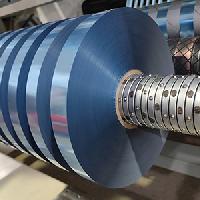Energy saving and consumption reduction practices for slitters: from blade design to power system optimization

Posted by slittermachine
from the Business category at
05 May 2025 06:25:38 am.
1. Blade design and material optimization
1. Efficient blade geometry
◦ Low resistance cutting edge type (e.g., parabolic edge) reduces cutting resistance and reduces energy consumption by 15-20%.
◦ Optimized Cutting angle angles (e.g., 20°-25°) balance sharpness with durability and reduce repetitive cuts caused by material sticking knives.
◦ Use the flute design to reduce cutting heat and reduce the need for lubrication.
2. High-performance material application
◦ Coating technology: TiAlN (titanium aluminum nitride) or DLC (diamond-like carbon) coating is used to extend the life of more than 30% and reduce the frequency of replacement.
◦ Cemented carbide: such as ceramic or CBN (cubic boron nitride) inserts, suitable for cutting high-hardness materials and reducing power loss.
3. Blade maintenance strategy
◦ Polishing the cutting edge regularly to avoid passivation and increase energy consumption.
◦ Adopt the online wear monitoring system to adjust the blade position in real time to avoid excessive wear.
Second, the power system energy-saving transformation
1. Efficient motor and transmission optimization
◦ Replaced with IE4/IE5 ultra-high efficiency motors, reducing energy consumption by 5-10%.
◦ Permanent magnet synchronous motor (PMSM): 10-15% higher efficiency in variable speed operation.
◦ Direct drive technology reduces gear/belt drive losses and increases efficiency by 3-5%.
2. Frequency conversion speed regulation technology
◦ Dynamically adjust the speed according to the thickness and hardness of the material to avoid wasting energy during constant high-speed operation.
◦ Equipped with an energy feedback unit, braking energy recovery for other equipment.
3. Hydraulic System Optimization (if applicable)
◦ Hydraulic pump is driven by servo motor to supply oil on demand and reduce overflow loss.
◦ Upgraded to proportional valve control for precise pressure/flow adjustment.
3. Lightweight mechanical structure and low-friction design
1. Lightweight components
◦ The frame is made of high-strength aluminum alloy or carbon fiber composite material to reduce the mass of moving parts.
◦ Optimize the roller structure (e.g., honeycomb hollow design) to reduce rotational inertia.
2. Low-friction technology
◦ Use self-lubricating bearings (e.g., graphene-coated bearings) or magnetic levitation bearings.
◦ Linear guides are replaced with roller guides, and the coefficient of friction is reduced by 40%.
Fourth, intelligent control and process optimization
1. Adaptive control system
◦ Adjust cutting parameters (such as feed rate, pressure) in real time through force sensor + AI algorithm.
◦ Machine learning historical data to optimize cutting paths and reduce idle strokes.
2. Energy monitoring platform
◦ Install smart meters, analyze the energy consumption of each module, and locate the high-energy-consuming links.
◦ Set the automatic standby mode to slow down or stop when the device is idle.
3. Process integration
◦ Implement the "one-cut, multi-cut" process (e.g., simultaneous slitting of multi-layer materials) to improve the efficiency of single processing.
◦ Optimize rewinding and unwinding tension control to reduce energy loss caused by material stretching.
5. Energy saving of auxiliary systems
1. Lubrication and cooling system
◦ Minimum quantity lubrication (MQL) replaces traditional spray cooling, reducing fluid consumption by 90%.
◦ Use phase change cooling techniques such as liquid nitrogen local cooling to reduce overall system load.
2. Compressed air is energy-saving
◦ If pneumatic clamping is used, switch to an electric clamping device or optimize the tubing layout (to reduce leakage).
6. Maintenance and management measures
1. Preventative maintenance program
◦ Regularly calibrate the concentricity of the equipment to avoid eccentric load and increase the load on the motor.
◦ Clean the heat dissipation channel to prevent the motor from overheating and the efficiency decreases.
2. Employee training
◦ Standardize operating procedures (e.g., avoid overloaded cutting) to reduce human energy waste.
Typical case reference
• Transformation effect of a packaging company:
Through the frequency conversion motor + intelligent control system, the overall energy consumption of the slitting machine is reduced by 22%, and the blade life is extended by 50%.
• Metal Slitting Machine Applications:
The use of CBN-coated blades and direct-drive motors reduces energy consumption per ton of material by 18%.
summary
The energy saving of the slitting machine needs to start from the multi-dimensional "equipment-process-management", and give priority to projects with high return on investment (such as frequency conversion transformation, high-efficiency blades). Combined with industry trends, digital twin technology can be used to further optimize energy efficiency and achieve green manufacturing in the future.
0 Comments



